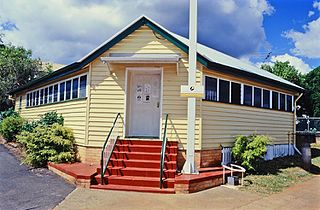
Beth-Eden is a heritage-listed villa at 85 Bank Road, Graceville, City of Brisbane, Queensland, Australia. It was designed by Richard Gailey and built from 1888 to 1910s. It is also known as Rakeevan and Verney. It was added to the Queensland Heritage Register on 21 October 1992.

St Mary's Presbytery is a heritage-listed Roman Catholic presbytery of St Mary's Roman Catholic Church at 142 Palmerin Street, Warwick, Southern Downs Region, Queensland, Australia. It was designed by Wallace & Gibson and built from 1885 to 1887 by John McCulloch. It is also known as Father JJ Horan's private residence. It was added to the Queensland Heritage Register on 31 July 2008.

Longreach railway station is the terminus station of the Central Western line, serving the town of Longreach, Longreach Region, Queensland, Australia. It is on the Landsborough Highway. It was built from 1887 to 1917. It was added to the Queensland Heritage Register on 12 December 2005.

Baree School of Arts is a heritage-listed school of arts at Creek Street, Baree, Rockhampton Region, Queensland, Australia. It was built in 1910. It was added to the Queensland Heritage Register on 25 January 2001.

Central State School is a heritage-listed state school at 44 Morgan Street, Mount Morgan, Rockhampton Region, Queensland, Australia. It was built from 1887 to 1997. It is also known as Boys School. It was added to the Queensland Heritage Register on 21 October 1992.

Commonwealth Bank Building is a heritage-listed bank at 38 Morgan Street, Mount Morgan, Rockhampton Region, Queensland, Australia. It was built c. 1913. It is also known as Queensland Savings Bank. It was added to the Queensland Heritage Register on 21 October 1992.

Mount Morgan Court House and Police Station is a heritage-listed courthouse and police station at 28 Hall Street, Mount Morgan, Rockhampton Region, Queensland, Australia. It was designed by Queensland Department of Public Works and built from 1898 to 1900 by John Macfarlane and Co. It was added to the Queensland Heritage Register on 21 October 1992.

Mount Morgan Masonic Temple is a heritage-listed masonic temple at 2 Gordon Street, Mount Morgan, Rockhampton Region, Queensland, Australia. It was designed by Eaton & Bates and built in 1903 by Newman Brothers. It was added to the Queensland Heritage Register on 21 October 1992.

St Mary's Anglican Church is a State heritage-listed church at 11 Gordon Street, Mount Morgan, Rockhampton Region, Queensland, Australia. It was designed and built in 1888–1889 by Scottish-born Thomas Glen Cornes (1842–1903), superintendent of sawmills and carpenters at the Mount Morgan Gold Mining Company Limited. It was added to the Queensland Heritage Register on 25 August 2000.

Avonleigh is a heritage-listed house at 248 Quay Street, Rockhampton, Rockhampton Region, Queensland, Australia. It was built in 1885 by Robert Cousins and Walter Lawson. It was added to the Queensland Heritage Register on 21 October 1992.

Block A of the Rockhampton Technical College is a heritage-listed technical college building at Bolsover Street, Rockhampton City, Rockhampton, Rockhampton Region, Queensland, Australia. It was designed by Thomas Pye and built in 1914. It is also known as Rockhampton College of T.A.F.E. and Rockhampton State High School and Technical College. It was added to the Queensland Heritage Register on 21 October 1992.

Criterion Hotel is a heritage-listed hotel at 150 Quay Street, Rockhampton, Rockhampton Region, Queensland, Australia. It was designed by James Flint and built from 1889 to 1890. It was added to the Queensland Heritage Register on 21 October 1992.

Rockhampton Club is a heritage-listed former club house at 166 Quay Street, Rockhampton, Rockhampton Region, Queensland, Australia. It was designed by James Flint and built from c. 1892 to 1893. It was added to the Queensland Heritage Register on 21 October 1992.

Australian Estates Building is a heritage-listed commercial building at 182 Quay Street, Rockhampton, Rockhampton Region, Queensland, Australia. It was built from 1861 to 1884. It is also known as Mansfield's Building and Luck House. It was added to the Queensland Heritage Register on 21 October 1992.

Rockhampton Post Office is a heritage-listed former post office at 80 East Street, Rockhampton, Rockhampton Region, Queensland, Australia. It was designed by George St Paul Connolly and built from 1892 to 1896 by Dennis Kelleher. It is also known as Rockhampton Post and Telegraph Offices. It was added to the Queensland Heritage Register on 24 January 2003.

St John's Anglican Church is a heritage-listed church at 278 Ford Street, Berserker, Rockhampton, Rockhampton Region, Queensland, Australia. It was built in 1912. It was added to the Queensland Heritage Register on 5 August 2003.

Goondiwindi Civic Centre is a town hall which is heritage-listed at 100 Marshall Street, Goondiwindi, Goondiwindi Region, Queensland, Australia. It was designed by Addison & MacDonald and built in 1937 by Thomas Charles Clarke, now known as The Clarke Services Group. It is also known as Council Chambers, Town Hall, and Civic Theatre. It was added to the Queensland Heritage Register on 9 July 1993.

Murgon Civic Centre is a heritage-listed town hall at 62–70 Lamb Street, Murgon, South Burnett Region, Queensland, Australia. It is also known as Murgon Public Hall. It was designed by Clifford Ernest Plant and built in 1938 by HG Neilsen. It was added to the Queensland Heritage Register on 9 November 2012.

Brisbane Boys' College Buildings are the heritage-listed private school buildings at Brisbane Boys' College, 55 Moggill Road, Toowong, City of Brisbane, Queensland, Australia. They were built from 1930 to 1950. They were added to the Queensland Heritage Register on 21 October 1992.

Mount Morgan State High School is a heritage-listed state high school and technical college at 4 Central Street, Mount Morgan, Rockhampton Region, Queensland, Australia. It was built in 1908. It was formerly known as Mount Morgan Technical College. It was added to the Queensland Heritage Register on 4 December 2015.

























